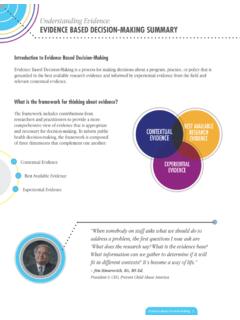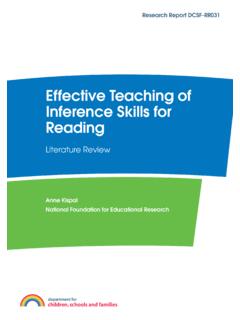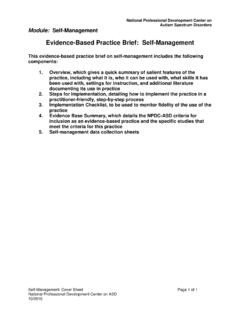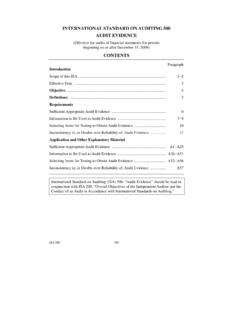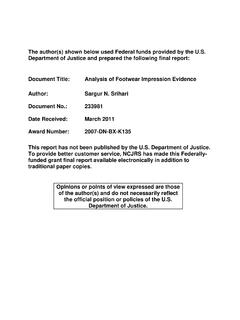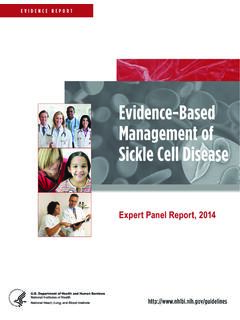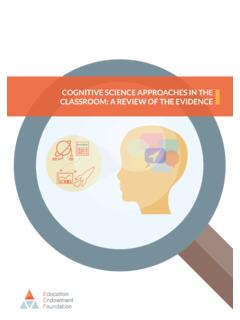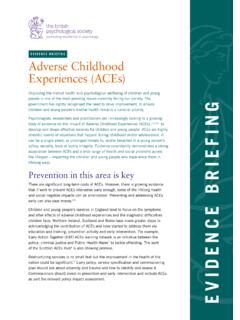Transcription of Student Goal Setting: An Evidence-Based Practice
1 This document was created by the Midwest Comprehensive Center. This document contains resources that are provided for the reader s convenience. These materials may contain the views and recommendations of various subject matter experts as well as hypertext links, research citations and websites to information created and maintained by other public and private organizations. The Department of Education does not control or guarantee the accuracy, relevance, timeliness, or completeness of any outside information included in these materials. The views expressed herein do not necessarily represent the positions or policies of the Department of Education. No official endorsement by the Department of Education of any product, commodity, service, enterprise, curriculum, or program of instruction mentioned in this document is intended or should be 2018 Student Goal Setting: An Evidence-Based PracticeStudent Goal SettingThe act of goal setting is a desired competency area for students associated with the learning-to-learn skills students need to engage in deeper learning (William and Flora Hewlett Foundation, 2013).
2 The act of goal setting, therefore, is a Practice that educators can use to help fuel students learning-to-learn skills, such as a sense of agency, intrinsic motivation, and capacity to manage their own learning. As an educational Practice , teachers interested in promoting learning-to-learn skills ask students to engage in goal setting within group advisories, during one-to-one advising sessions, and as an integral component of the students personalized learning State and Local Lists of Evidence-Based PracticesSchools that are interested in promoting Student agency, intrinsic motivation, and other self-management skills may want to consider the evidence base for the array of strategies and structures associated with a focus on these intrapersonal skills.
3 The Elementary and Secondary Education Act (ESEA) of 1965 (2015) (ESEA Section 8101(21)(A))1 allows states to take a lead role in identifying suitable Evidence-Based practices . As outlined in Table 1, the Department of Education has established four levels to denote the strength of the evidence base for a particular intervention, educational strategy, or Practice ( Department of Education, 2016).1 All references to ESEA in this document refer to the Elementary and Secondary Education Act of 1965 as amended by the Every Student Succeeds Act of 1. Four Tiers of evidence Strong EvidenceAt least one experimental study that shows a statistically significant and positive effect without being overridden by other statistically negative evidence .
4 Study must have a large, multisite sample with overlap in both setting and EvidenceAt least one quasi-experimental study that shows a statistically significant and positive effect without being overridden by other statistically negative evidence . Must have a large, multisite sample with overlap in either population or EvidenceAt least one correlational study with statistical controls that shows a significant and positive effect without being overridden by other statistically negative a RationaleStrategies that are based on a well-specified theory or logic model informed by research or evaluation that suggests a likelihood of producing positive benefits for evidence standards: GOAL SETTING: AN Evidence-Based Practice ASSOCIATED WITH DEEPER LEARNING2 This resource focuses on one Practice area Student goal setting.
5 This resource includes a brief summary of the research, highlights promising goal-setting practices , and provides the results of a research evidence review2 that indicates that there is promising (Tier III) evidence for the Practice of Student goal setting ( Department of Education, 2018). Student Goal SettingThe Practice of goal setting is believed to increase students goal-setting skills and also increase students self-efficacy and intrinsic motivation to further their learning. In his synthesis of goal-setting research, Schunk (2003) explains that students use goals to direct their actions, assess their progress, and drive their own learning over time (Schunk, 2003).
6 Locke and Latham (1990) explain that a key premise for goal theory is that that the nature of the goals that students set influences their performance, with higher goals being positively associated with higher task performance. Furthermore, goal theory suggests that the link between goal setting and task performance is mediated by a cycle of self-regulated learning. As explained by Schunk (1990, p. 71), as learners work on tasks, they observe their own performances and evaluate their own goal progress. Self-efficacy and goal setting are affected by self-observation, self-judgment, and self-reaction. When students perceive satisfactory goal progress, they feel capable of improving their skills; goal attainment, coupled with high self-efficacy, leads students to set new challenging goals .
7 What Is the Research evidence for Goal Setting?There have been several decades of research on goal setting with many of these studies taking place between 1960 and the late 1990s in work place settings (Latham & Locke, 2007; Tubbs, 1986). Across the years, numerous studies have also been conducted with K 12 and college students . The results of these studies suggest that goal setting may be associated with multiple, positive benefits, for a range of ages and abilities, across academic subject areas and in varying geographic locations in the United States and abroad. A review of several studies of goal setting suggests that the Practice is associated with positive academic benefits for students across a wide 2A review of selected research studies on Student goal setting was conducted by the REL Midwest and approved by the Institute of Education Sciences (IES) in January 2018.
8 The results of this review suggest that there is promising evidence for Student goal setting. A summary of the results of this review is provided in Appendix A. A review of several studies of goal setting suggests that the Practice is associated with positive academic benefits across a wide range of academic subject GOAL SETTING: AN Evidence-Based Practice ASSOCIATED WITH DEEPER LEARNING3range of academic subject areas, including reading (Schunk & Rice, 1989; 1991), writing (Schunk & Swartz, 1993), foreign language study (Moeller, Theiler, & Wu, 2012), social studies (Zimmerman, Bandura, & Martinez-Pons, 1992), science (Meece, Blumenfeld, & Hoyle, 1988), and mathematics (Bandura & Schunk, 1981).
9 Research on goal setting has also shown links with a range of outcomes associated with the deeper learning intrapersonal domain, such as self-regulated learning (Ames & Archer, 1988; Pajares, Britner & Valiant, 2000), self-efficacy (Bandura & Schunk, 1981; Schunk & Rice, 1989), intrinsic motivation (Murayama & Elliott, 2009), and cognitive engagement (Meece et al., 1988). For example, a large, correlational study of high school-aged students conducted in Japan (Murayama & Elliot, 2009) examined the joint influence of goal orientation and classroom goal focus on students intrinsic motivation and self-concept in mathematics. This study found that, in classrooms where teachers emphasized a mastery goal orientation, students were more likely to adopt a personal mastery goal orientation.
10 students in these classrooms were also more likely to have higher intrinsic motivation. Conversely, in classrooms where students reported that teachers emphasized a performance goal orientation, students showed lower intrinsic motivation as well as lower self-concept. One five-year, correlational study of comprehensive high school students in 23 high schools3 (Moeller et al., 2012) examined the relationship between participation in regular goal setting and second language performance. Although this study had a nonexperimental design, its descriptive findings offer a research rationale for how students participation in a systematic goal-setting Practice might lead to incremental growth in goal-setting ability, and subsequently to gains in academic performance over on Student goal setting suggests that this Practice is associated with positive outcomes for students of differing ability levels, from those who are academically advanced (Ames & Archer, 1988) to those who struggle academically (Bandura & Schunk, 1981; Morisano, Hirsh, Peterson, Pihl, & Shore, 2010) to those students with identified learning disabilities (Schunk, 1985.)










